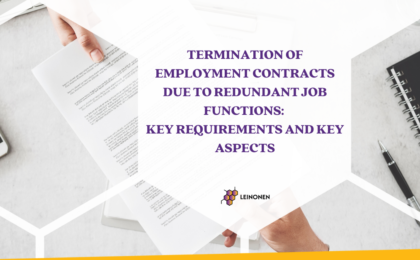Typical situations, when the supply or transfer of goods from Lithuania to another EU country is subject to VAT taxation in Lithuania. Making analysis of various VAT schemes of our Clients, we have noticed, that Clients do not take into account the negative tax consequences, related to the transferring of various goods from Lithuania to another EU countries. Therefore, the aim of this Article is to pay attention to the most typical situations, when the transfer of goods for business purposes from Lithuania to another EU countries, could be more expensive, due to the VAT charged in Lithuania.
Below are the questions, related to the most common situations, where taxation of transactions is made with mistakes:
1. Supply of goods to the EU:
- Are there situations, when customer from the EU country refused to accept your goods, e.g. on the basis of quality, colour or some other reasons?
2. Transfer of goods to another EU country for other purposes:
- Do you transfer your own goods (equipment) for business purposes from Lithuania to another EU country, which will not be returned back to Lithuania (e.g. transfer of equipment for production, movable property for the rent, office equipment, etc.)?
- Do you transfer tools or equipment for construction works, which take place in another EU country?
- Do you transfer goods to exhibitions, which take place in the EU country where the goods may be sold?
- Do you transfer the goods for processing to another EU country and after the processing, the goods will be sold in that country?
If you have answered positively at least to one question, then the transfer of goods from Lithuania to the EU country may be taxed with VAT in Lithuania. Moreover, due to incorrect VAT taxation of transactions, the Company may incur additional late payment interest or penalties.
In relation to the situations mentioned above, below are the VAT obligations, which derives from the transfer of goods from Lithuania to another EU country:
- transfer of own goods for business purposes from Lithuania to another EU country is treated as VAT taxable supply, which may be subject to 21%, 9%, 5% or 0% VAT rates;
- VAT invoice should be issued for the transfer of own goods;
- VAT payer transferring own goods, may apply 0% VAT rate to such supplies, if it is registered for VAT purpose in another EU country, otherwise – such transfer is going to be subject to the “Lithuanian” VAT;
- transferring of goods from Lithuania to another EU country should be treated as intra – Community acquisition of goods in the EU country of arrival of goods;
- successive supply of goods in the EU country of arrival should be subject to the local VAT;
- due to intra – Community acquisition and successive supply of goods, VAT registration obligation might occur in the EU country of arrival to the Lithuanian entity transferring goods from Lithuania to another EU country.
Provisions of the Lithuanian VAT Law and the VAT Directive
Before analysing situations mentioned above, first of all it is worth mentioning the Articles of the Lithuanian VAT Law and the VAT Directive, which specify the transfer of own goods for business purposes.
I. What is the meaning of the transferring of goods for business purposes?
In order to control the movement of goods and to avoid the tax abuse cases, the transfer of goods by a taxable person forming the part of his business assets to another EU country shall be treated as a supply of goods for consideration (according to Article 5 – 1, Part 1 of Lithuanian VAT Law / Article 17, Part 1 of the Directive 2006/112/EB (hereinafter – the VAT Directive).
For this purpose, the transfer of goods from Lithuania to another EU country, when the owner of goods is not changed, is treated as a supply of goods. Noteworthy that it could be vice versa, when own goods are transferred to Lithuania from another EU countries, i.e. such transfer may be treated as intra – Community acquisition of goods in Lithuania.
The term “business purposes” should be understood as performance of an economic activity, i.e. transfer of goods to another EU country should be connected with ongoing supply of goods or services in another EU country.
A VAT invoice should be issued for the transfer of own goods from Lithuania to another EU country where the suppliers and the purchaser of goods is the same company.
If a company is registered for VAT purposes in another EU country, in the VAT invoice issued the supplier of goods would be the company with its Lithuanian VAT number and the purchaser of goods – the same company with its VAT number from another EU country. If the company is not registered for VAT purposes in other EU Countries (i.e. it has only Lithuanian VAT number) then the information about the supplier and the purchaser will be the same in the VAT invoice issued for the transfer of goods.
Therefore, the company may apply 0% VAT rate to the transfer of own goods from Lithuania to another EU country if:
- the company is registered for VAT purposes in another EU country and
- the goods are actually transported from Lithuania to another EU country and the company has documents supporting transportation of goods.
The transfer of own goods from Lithuania to another EU country may be subject to Lithuanian VAT, if at least one of the conditions mentioned above are not met.
II. What are the cases, when the transfer of goods shall not be treated as a supply of goods for consideration?
According to Article 5-1, Part 2 of the VAT Law (Article 17, Part 2 of the VAT Directive), the transfer of goods from Lithuania to another EU country is not treated as a supply of goods for consideration, if it is in line with the exhaustive list, which is provided below:
- transfer of goods to another EU country regarding the distance sales;
- transfer of goods to another EU country where the goods are going to be installed or assembled and where the supply of goods will take place;
- transfer of goods to another EU country with the purpose to supply these goods on the board ships, aircraft and (or) on trains transporting passengers in the EU territory and when the supply of goods will take place in that EU country;
- transfer of goods to another EU country due to supply the goods subject to 0% VAT rate based on Chapter VI of the Lithuanian VAT Law (except Article 53 of VAT Law);
- transfer of goods to another EU country for performance of services (repair, maintenance, adaptation, etc.), processing and (or) reprocessing, if after being processed these goods will be returned to that taxable person in the EU country, from which they had initially been dispatched or transported;
- the transfer of goods to another EU country for temporary use of goods within the territory of the EU country in which dispatch or transport of goods ends, for the purposes of the supply of services by the taxable person established within the EU country in which dispatch or transport of goods began (i.e. until they are needed in another EU country for the provision of the services);
- temporary transfer of goods to another EU country for the temporary use of goods, for a period not exceeding 24 months, within the territory of another EU country, in which the importation of the same goods from a third country with a view to their temporary use would be covered by the arrangements for temporary importation with full exemption from import duties;
- transmission of gas within the EU territory through the natural gas system or any network connected to such a system to another EU country, transmission of heating or cooling energy through heating or cooling networks to another EU country, transmission of electric power to another EU country (provided that provisions in substance equivalent to provisions of Article 12, Part 6 of the VAT Law).
We would like to pay your attention, that the transfer of own goods for the business purposes should not be considered as supplies of goods, as long as the above-mentioned conditions are fulfilled.
In practise, there are cases, when business representatives have no intentions to return goods from another EU country back to Lithuania, e.g. goods are sold in another EU country because it was economically beneficial.
III. What does happen when the transfer of goods is no longer appropriate to conditions mentioned above?
According to Article 5-1, Part 3 of the VAT Law (Article 17, Part 3 of the VAT Directive), if the conditions mentioned above is no longer met, then goods shall be regarded as having transferred to another EU country. In such cases, the transfer shall be deemed to take place at the time when that condition ceases to be met. This is the time when additional VAT obligations and tax risks might occur.
The overview of practical situations
1. Supply of goods to EU country
Goods are supplied from Lithuania to another EU country to the customer, who is a VAT taxpayer. The customer wants to return a part of the goods, e.g. on the basis of quality, colour or any other reasons. The supplier, Lithuanian company, issues a credit note to the customer for the returning of goods. Taking into account, that it is not economically beneficial to return goods back to Lithuania, the supplier finds another buyer in this EU country and immediately sells goods with the discount.
During the second supply of goods to the new customer, Article 5 – 1, Part 2 (4) of the VAT Law (Article 17, Part 2 (e) of VAT Directive) is not applied any more to the first supply of goods and the supplier, Lithuanian company, if it is not registered as a VAT tax payer in another EU country, shall calculate VAT in Lithuania for such supply of goods, i.e. transfer of own goods from Lithuania to another EU country. This provision was confirmed by the Supreme Administrative Court of Lithuania in the decision No. A602-996/2013.
2. Transfer of goods to another EU country
2.1 Rent. For example, the Lithuanian company has rented the equipment to another company in the EU country for 1 year period. The equipment was transported from Lithuania to that EU country for the rent period. At the end of the rent period, the Lithuanian company decided to sell the equipment to the renter, i.e. the transaction occurs in the EU country, where the equipment was transferred for rent.
When the company decides to sell the equipment, Article 5 – 1, Part 2 (6) of the VAT Law (Article 17, Part 2 (g) of the VAT Directive) is not applied, and the Lithuanian company should calculate VAT in Lithuania, if it is not registered as a VAT taxpayer in another EU country.
2.2 Transfer of equipment for the construction works. Lithuanian company transfers equipment from Lithuania to another EU country for construction works. If the equipment for construction works will not be returned back to Lithuania after the completion of services, i.e. it will be sold in that EU country, Article 5 – 1, Part 2 (6) of the VAT Law (Article 17, Part 2 (g) of the VAT Directive) will no longer be applied and the Lithuanian company, if it is not registered as a VAT taxpayer in another EU country, should calculated VAT in Lithuania.
2.3 Exhibition. Lithuanian company transfers goods to the exhibitions in another EU country. During the exhibition, the customer has intention to buy some goods. Lithuanian company sells the goods and they will not be returned back to Lithuania.
Due to such supply of goods, Article 5 – 1, Part 2 (6) of the VAT Law (Article 17, Part 2 (g) of the VAT Directive) is no longer applicable and the Lithuanian company, if it is not registered as a VAT taxpayer in another EU country, should calculate VAT in Lithuania.
2.4 Manufacturing. The Lithuanian company A transfers goods to Germany for manufacturing, according to Article 5 – 1, Part 2 (5) of the VAT Law (Article 17, Part 2 (f) of the VAT Directive). The Company A does not return the goods manufactured to Lithuania, and sells them to Germany’s or other EU countries’ companies, who are VAT taxpayers. Since the Company A does not return goods back to Lithuania, it is treated as a supply of goods to another EU country (Germany) from the moment when they were sold to the final customer, i.e. German company. Accordingly, if the Lithuanian company A is not registered as a VAT taxpayer in other EU country, VAT should be calculated according to the standard rate (21%) in Lithuania.
It is important to mention, that both, the VAT Directive and the Lithuanian VAT Law, provide that the goods remanufactured must be returned to that taxable person, who has shipped the goods from Lithuania to another EU country. Therefore, if the goods will be returned to Lithuania, but to another taxable person, the company could not avoid the negative tax consequences.
In all cases mentioned above, if the circumstances of the transactions are changed, there is a risk:
- At the moment of supply of goods in another EU country, transfer of goods for business purposes from Lithuania to another EU country might occur, which will be VAT taxable in Lithuania (applicable 21%, 9%, 5% or 0% of VAT rate). Moreover, the VAT invoice should be issued for such transfer of goods;
- An obligation to register for VAT purposes might occur to the Lithuanian company in the EU country where the supply of goods takes place;
- The supply of goods in another EU country could be subject to local VAT tax.
In order to avoid the negative tax consequences when the customer returns a part of goods after the initial supply of goods to the EU country, the following actions could be done:
- To supply the goods with the discount to the original customer;
- To return goods back to Lithuania;
- To register as a VAT taxpayer in another EU country.
In other cases when goods are transferred to the EU countries and the conditions listed in Article 5-1, Part 2 of the VAT Law (Article 17, Part 2 of the VAT Directive) are no longer met, the following actions could be taken:
- To return goods back to Lithuania;
- To register as a VAT taxpayer in another EU country.
To summarize, in the case when the company transfers own goods for business purposes from one EU country to another, we advise to evaluate, whether such transfer will not evoke an additional VAT burdens, to evaluate the risk of VAT value per each transaction, taking into account the transaction amount, and consider possible actions in order to avoid negative tax consequences.




